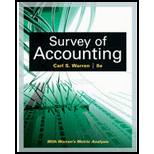
Cost-plus and target costing concepts
The following conversation took place between Dean Lancaster, vice president of marketing, and Dina Conaway, controller of Redwood Computer Company:
Dealt: I am really excited about our new computer coming out. 1 think ii will lx* a real market success.
Dina: I'm really glad you think so. I know that our success will In- determined by our price. If our price is too high, our competitors will be the ones with the market success.
Dean: Don't worry about it. We'll just mark our product cost up by 25% and it will all work out. I know we'll make money at those markups. By the way. what does the estimated product com look like?
Dina: Well, there's the rub. The product cost looks as if it's going 10 come in at around $1,000. With a 25% markup, that will give us a selling price of $1,250.
Dean: I see your concern. That's a little high. Our research indicates that computer prices are dropping and that (his type of computer should be selling for around $900 when we release it to the market.
Dina: I'm not sure what to do.
Dean: Let me see if I can help. How much of the $1,000 is fixed cost?
Dina: About $300.
Dean: There you go. The fixed cost is sunk. We don't need to consider it in our pricing decision. If we reduce the product cost by $300, the new price with a 25% markup would be right at $875. Boy, I was really worried for a minute there. 1 knew something wasn't right.
1.If you were Dina, how would you respond to Dean's solution to the pricing problem?
Want to see the full answer?
Check out a sample textbook solution
Chapter 12 Solutions
Survey of Accounting - With CengageNOW 1Term
- What is the allocated rate, weight bas per the cups, tablecloths, and bottles?arrow_forwardWhat is the company's return on common stockholder's equity for 2022 on these financial accounting question?arrow_forwardJones Engineering has $60,000 in assets. They also have $25,000 in liabilities and $5,000 in expenses, and they paid out $7,500 in dividends this year. The extended accounting equation is assets = liabilities + (revenue (expenses + dividends)). What would their revenue need to be for their accounts to be in balance? a) $47,500 b) $35,000 - c) Not enough information d) $20,000arrow_forward
 Managerial AccountingAccountingISBN:9781337912020Author:Carl Warren, Ph.d. Cma William B. TaylerPublisher:South-Western College Pub
Managerial AccountingAccountingISBN:9781337912020Author:Carl Warren, Ph.d. Cma William B. TaylerPublisher:South-Western College Pub Managerial Accounting: The Cornerstone of Busines...AccountingISBN:9781337115773Author:Maryanne M. Mowen, Don R. Hansen, Dan L. HeitgerPublisher:Cengage Learning
Managerial Accounting: The Cornerstone of Busines...AccountingISBN:9781337115773Author:Maryanne M. Mowen, Don R. Hansen, Dan L. HeitgerPublisher:Cengage Learning Cornerstones of Cost Management (Cornerstones Ser...AccountingISBN:9781305970663Author:Don R. Hansen, Maryanne M. MowenPublisher:Cengage Learning
Cornerstones of Cost Management (Cornerstones Ser...AccountingISBN:9781305970663Author:Don R. Hansen, Maryanne M. MowenPublisher:Cengage Learning


